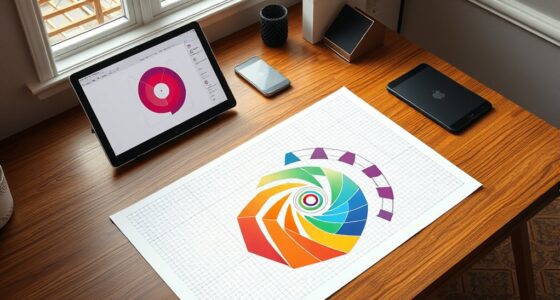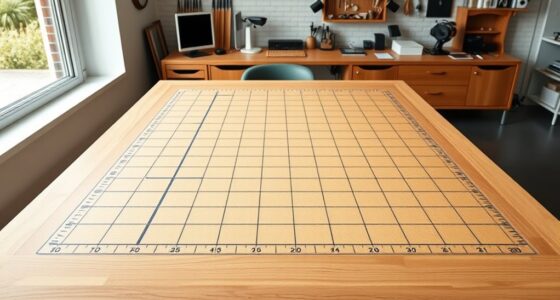The science of visual balance combines psychology and perception to explain how your eyes and brain interpret harmony and stability in design. It involves understanding the types of balance—symmetrical, asymmetrical, and radial—and how visual weight, color, contrast, and grid systems influence the viewer’s eye movement. Recognizing common mistakes and cultural perceptions can help craft more engaging, harmonious compositions. Keep exploring to discover how these principles can transform your visual work.
Key Takeaways
- Visual balance involves distributing visual weight to create harmony and perceived stability in a design.
- The brain subconsciously seeks symmetry and order, influencing how we perceive balance and harmony.
- Color, contrast, and element placement affect visual weight and overall balance within compositions.
- Cultural norms and perceptual biases shape individual responses to balance and stability cues.
- Effective use of grid systems and balance types (symmetrical, asymmetrical, radial) enhances visual harmony.
Understanding the Concept of Visual Balance

Have you ever noticed how some images or designs feel naturally pleasing while others seem unbalanced? That’s because of perceived harmony, which plays a key role in creating aesthetic equilibrium. Visual balance isn’t just about symmetry; it’s how your eyes naturally distribute weight across a design. When elements are arranged thoughtfully, they evoke a sense of stability and order. Your brain instinctively seeks this harmony, making the design more appealing. Achieving this balance involves distributing visual “weight” evenly or intentionally creating contrast to guide the viewer’s eye. Understanding the concept of visual balance helps you craft compositions that feel right, engaging, and visually satisfying. It’s about creating a sense of harmony that appeals to the subconscious preferences of your audience. Additionally, awareness of regional legal resources can influence how you approach design elements to ensure clarity and effectiveness. Recognizing how visual weight impacts overall composition can help you make more informed design choices that resonate with viewers, especially when considering aesthetic principles that govern visual harmony. Moreover, understanding Visual balance can improve your ability to communicate messages effectively through visual means, making your designs more compelling and memorable. Developing an eye for visual harmony can further enhance your overall design sensibility and improve viewer engagement.
Types of Visual Balance in Design
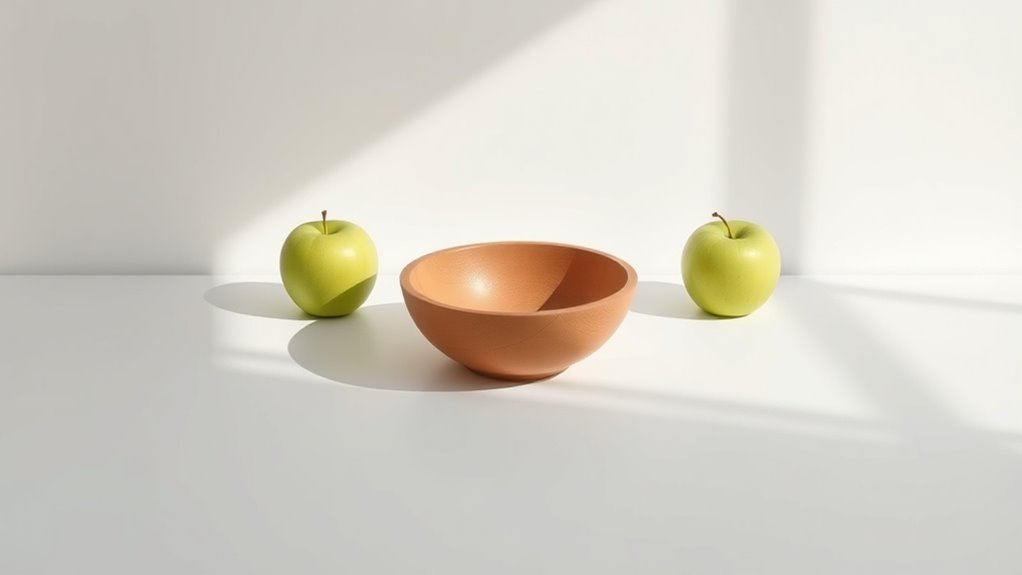
There are several key types of visual balance that designers use to create harmony and guide the viewer’s eye effectively. These include different approaches that emphasize stability and interest within your composition. Symmetrical balance, for example, achieves harmony through mirror-image elements, while asymmetrical balance relies on visual weight distribution. You can also utilize radial balance, where elements radiate from a central point, and tension balance, which creates dynamic energy. Incorporating color harmony helps unify the design, ensuring colors complement each other for a balanced look. Typography contrast enhances visual interest, balancing text with images or whitespace. By understanding these types, you can craft designs that feel cohesive yet engaging, guiding viewers seamlessly through your visual story. Additionally, studying anime movies can inspire creative approaches to visual harmony through storytelling and stylized imagery. Recognizing color theory principles can further refine your use of color to achieve more effective balance and emotional impact in your designs. Exploring subconscious processes can also deepen your understanding of how viewers perceive and respond to visual elements intuitively.
The Role of Symmetry and Asymmetry

Symmetry and asymmetry play essential roles in shaping a design’s visual balance, each offering distinct ways to engage viewers. Symmetry creates harmony through mirror reflections, giving your composition a sense of order and stability. When elements are balanced evenly on either side, viewers feel at ease, drawn into the design’s natural rhythm. Conversely, asymmetry introduces asymmetrical tension, intentionally disrupting balance to create visual interest. This tension guides the eye across the composition, encouraging exploration and engagement. You can achieve dynamic energy by carefully balancing asymmetric elements, making the design feel lively rather than static. Both approaches rely on understanding how visual weight and placement influence perception, ensuring your design communicates effectively and maintains viewer interest. Recognizing the importance of natural environments in design can also inspire more balanced compositions that resonate with viewers. Mastering the use of visual weight allows designers to manipulate focal points and create more engaging, memorable layouts. Additionally, considering environmental context helps in aligning the design’s balance with its surroundings, enhancing overall harmony. Paying attention to contextual factors can further refine the balance, making your design more adaptable and impactful. Incorporating a variety of elements can help achieve a harmonious balance that appeals to diverse audiences.
How the Eye Moves Across a Composition
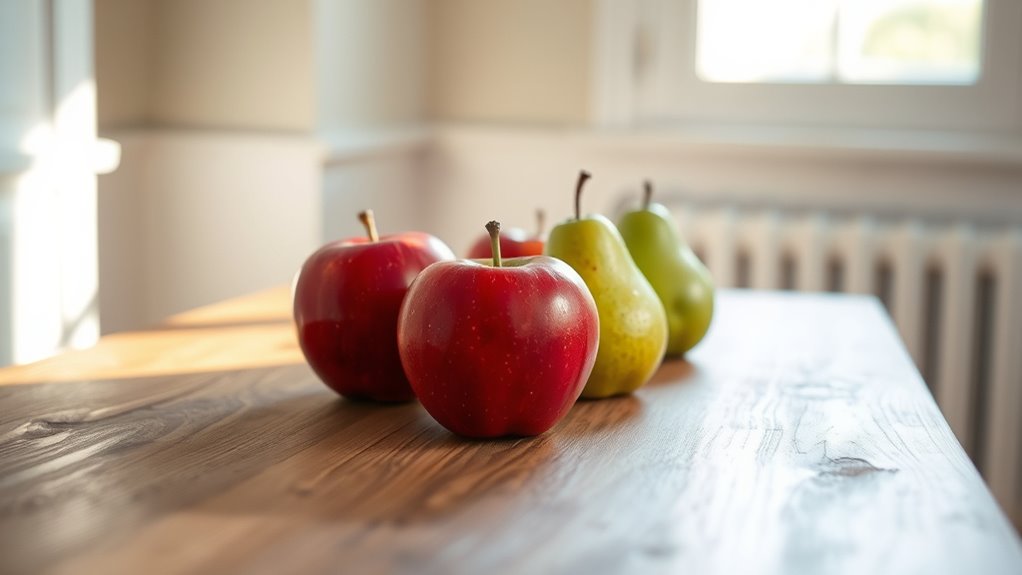
Understanding how the eye moves across a composition helps you craft designs that guide viewers naturally and efficiently. Your eye typically follows specific eye movement patterns during visual scanning, moving in a predictable, often zigzag or sweeping manner. This pattern starts at focal points, such as prominent elements, then moves across the layout, seeking visual balance and harmony. Recognizing these patterns allows you to position key elements strategically. Additionally, incorporating visual storytelling techniques can enhance the viewer’s engagement and comprehension of the design. Being aware of visual pathways helps in directing attention precisely where you want it. Awareness of eye movement patterns enables designers to optimize the placement of elements to maximize impact and clarity. Understanding how visual hierarchy influences eye movement can further improve the effectiveness of your compositions. Moreover, understanding personality traits can assist in tailoring designs to specific audiences, making visual communication even more effective.
Psychological Principles Behind Visual Stability

Our perception of visual stability relies heavily on psychological principles that influence how we interpret balance and harmony in a composition. Perceptual biases shape your expectations, making certain arrangements feel more stable or pleasing. For example, you tend to favor symmetrical layouts because they align with your innate aesthetic preferences for order and predictability. Your brain automatically filters visual information, prioritizing elements that conform to these biases, which enhances your sense of balance. Additionally, your aesthetic preferences can cause you to perceive some compositions as more stable, even if they aren’t perfectly balanced mathematically. Recognizing the role of subconscious biases helps you understand why certain designs feel more harmonious, guiding you to create images that resonate on a subconscious level. The way your brain processes visual cues is influenced by perceptual organization, which plays a crucial role in how we interpret and respond to visual stimuli. Incorporating visual organization techniques can further influence perceptions of stability and appeal. Furthermore, understanding visual perception mechanisms allows designers to intentionally craft compositions that evoke specific emotional responses and a sense of harmony.
The Impact of Color and Contrast on Balance
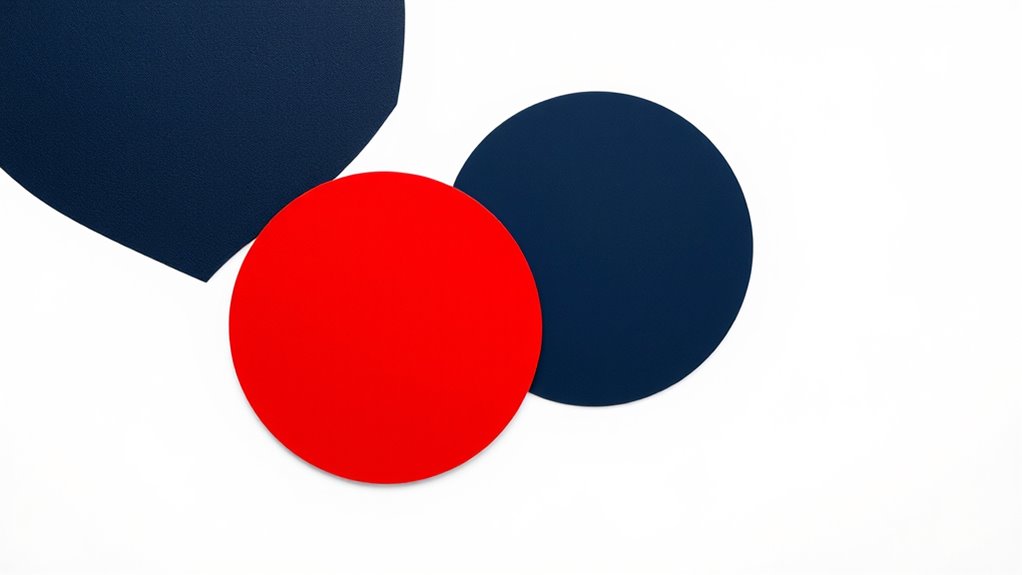
Color and contrast play an essential role in establishing visual balance by guiding your eye and creating focal points within a composition. Understanding color psychology helps you choose hues that evoke specific emotions and direct attention subtly. Contrast dynamics influence how elements stand out against each other, affecting overall harmony. High contrast draws focus, while softer contrasts create calmness and unity. To leverage these effects:
- Use bold colors strategically to highlight key areas
- Balance warm and cool tones for emotional impact
- Vary contrast levels to establish visual hierarchy
- Be mindful of color combinations that may cause imbalance or confusion
Mastering color and contrast helps you craft compositions with clear, engaging visual flow. When applied thoughtfully, these elements shape perception and reinforce the overall balance of your design. Recognizing the importance of visual balance in design can significantly enhance viewer engagement and message clarity. Additionally, incorporating contrast variations can help maintain viewer interest and emphasize critical elements effectively. Understanding how color contrast interacts with other design elements further enhances your ability to create harmonious and visually appealing compositions.
Using Grid Systems to Achieve Balance
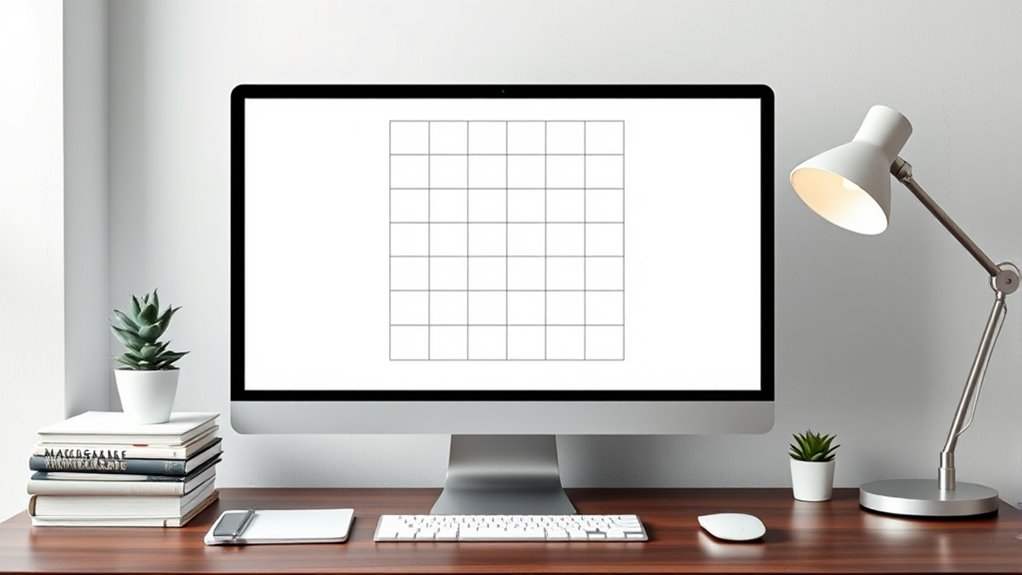
Using grid systems helps you organize elements for visual harmony. By applying grid layout principles, you can balance symmetry and asymmetry to guide the viewer’s eye. Understanding how to distribute visual weight guarantees your design feels stable and engaging.
Grid Layout Principles
Implementing grid systems is a powerful way to achieve visual balance in your designs. By focusing on proper grid alignment, you ensure elements are structured logically, guiding the viewer’s eye smoothly across the layout. Consistent spacing maintains harmony, preventing clutter and emphasizing importance. To master grid layout principles, consider these key points:
- Use a clear grid structure to organize elements effectively
- Align objects precisely along grid lines for coherence
- Maintain spacing consistency to unify different sections
- Adjust grid proportions to create visual rhythm and emphasis
Applying these principles helps your design feel balanced, professional, and easy to navigate. With careful attention to grid alignment and spacing consistency, your visuals will communicate clearly and attractively.
Symmetry and Asymmetry
Achieving visual balance with grid systems involves carefully balancing symmetry and asymmetry to create engaging and harmonious designs. Symmetry provides a sense of stability and order, establishing a static, predictable dynamic equilibrium. It aligns elements evenly, making the design feel formal and balanced. Conversely, asymmetry introduces visual tension, making compositions more dynamic and intriguing. By intentionally offsetting elements, you can generate a lively sense of movement while maintaining overall harmony. Using grid systems helps you manage this balance precisely; grids serve as frameworks to position elements thoughtfully. When you combine symmetry and asymmetry skillfully within these grids, you craft designs that feel both balanced and vibrant, capturing viewers’ attention and guiding their eyes naturally across your work.
Visual Weight Distribution
To create a balanced design, you need to carefully distribute visual weight across your layout. Using grid systems helps you achieve this by organizing elements methodically. Consider how color harmony influences weight; bold or contrasting colors draw attention, requiring balancing with subtler tones. Typography balance is equally essential—larger or heavier fonts feel more substantial, so offset them with smaller text.
Key strategies include:
- Aligning elements to maintain consistent rhythm and flow
- Adjusting spacing to distribute emphasis evenly
- Using color contrast deliberately for visual emphasis
- Ensuring typography varies in weight for harmony
Common Mistakes That Disrupt Visual Harmony

One common mistake that disrupts visual harmony is uneven distribution of visual weight across a design or composition. When you neglect balance, elements like color harmony can feel off, causing the eye to drift unevenly. Similarly, poor font pairing can create visual tension, making sections look mismatched or uncoordinated. Overloading one area with bright, contrasting colors draws too much attention, upsetting the overall flow. Conversely, using fonts that clash or lack consistency can break the unity of your design. These mistakes make your work feel unintentional and chaotic, rather than balanced and cohesive. To maintain harmony, *guarantee* your color choices complement each other and your fonts work well together, guiding the viewer smoothly through the composition.
Practical Techniques for Enhancing Balance

You can improve visual balance by playing with symmetry and asymmetry to create harmony or tension. Adjusting the visual weight of elements helps guide the viewer’s eye and enhances overall cohesion. Small changes in placement or size can make a big difference in achieving a balanced composition.
Symmetry and Asymmetry
Symmetry and asymmetry are powerful tools for creating visual balance, and understanding how to use them can considerably enhance your designs. Symmetry offers a sense of stability and order, making your focal points feel harmonious and intentional. Asymmetry, on the other hand, introduces dynamic tension that captures attention and guides the viewer’s eye across the composition. To effectively utilize these techniques:
- Use color harmony to reinforce balance within symmetrical layouts.
- Highlight focal points strategically to draw attention without disrupting symmetry.
- Balance asymmetrical elements by considering their visual weight.
- Experiment with combining both for a lively, engaging design.
Mastering the interplay of symmetry and asymmetry helps you craft visuals that feel natural, engaging, and well-balanced, elevating your overall design approach.
Use of Visual Weight
Have you ever noticed how some elements seem to draw your eye more than others? That’s the effect of visual weight, which influences compositional balance. To enhance this, you can deliberately adjust the size, color, or placement of elements. Heavier visual weight attracts attention and can anchor a design, while lighter elements create openness. Use this table to guide your choices:
| Element Type | Effect on Visual Weight |
|---|---|
| Large objects | Increase visual weight, anchor design |
| Bright colors | Draw more attention, add weight |
| Central placement | Balances composition, feels stable |
| Dark shades | Add perceived weight, ground elements |
| Minimal elements | Reduce visual weight, create lightness |
Mastering visual weight helps you achieve better compositional balance in your designs.
The Influence of Cultural Perceptions on Balance

Cultural perceptions considerably shape how people interpret and prioritize visual balance. Your cultural background influences which elements you see as stable, harmonious, or imbalanced, rooted in cultural symbolism and perceptual differences. For example, certain colors or shapes hold specific meanings across cultures, affecting how you perceive a balanced composition. These perceptual differences can lead to contrasting judgments of what feels “right” or “off” in design.
- Cultural symbolism guides your interpretation of visual elements
- Perceptual differences cause varied responses to balance
- Cultural norms influence the placement of focal points
- Different societies prioritize symmetry or asymmetry differently
Frequently Asked Questions
How Does Cultural Background Influence Perceptions of Visual Balance?
You might notice that cultural background influences how you perceive visual balance, as cultural symbolism shapes your aesthetic preferences. Perceptual differences arise because your cultural experiences affect what feels harmonious or unbalanced. For example, certain symbols or colors hold specific meanings in your culture, altering your sense of visual equilibrium. Understanding these influences helps you appreciate diverse perspectives on balance, recognizing that perceptions vary based on cultural symbolism and individual experiences.
Can Digital Screens Affect Our Sense of Visual Stability Differently?
Think of your eyes as a tightrope walker, constantly adjusting to maintain balance. Digital screens, with their flickering lights and rapid shifts, challenge your perceptual adaptation, making it harder to stay steady. Over time, this can lead to visual fatigue, disrupting your sense of stability. Yes, screens can subtly sway your perception, forcing your visual system to work harder and affecting your overall sense of visual harmony.
What Role Does Motion Play in Maintaining Visual Balance?
Motion plays a essential role in maintaining your visual balance by influencing your dynamic equilibrium and motion perception. When objects move, your brain quickly processes these changes, helping you stay oriented and stable. This active perception allows you to adapt to shifting environments, ensuring your sense of balance remains intact. Without accurate motion perception, you might feel disoriented or unsteady, highlighting how significant motion is in keeping your visual stability.
How Do Different Artistic Styles Interpret Visual Harmony?
Imagine viewing a minimalist painting with clean lines and balanced asymmetry, creating harmony through simplicity. Different artistic styles interpret visual harmony uniquely: symmetry often offers stability, while asymmetry introduces dynamic interest. Maximalist art uses bold colors and dense details to achieve balance, contrasting with minimalist works that rely on negative space. Whether in classical or contemporary art, these styles shape how you perceive harmony, emphasizing either order or lively energy.
Is There a Universal Standard for Perfect Visual Balance?
You might wonder if there’s a universal standard for perfect visual balance. While aesthetic consistency guides many artists, compositional symmetry isn’t always necessary for harmony. Your goal should be to create a balanced composition that feels right to you, even if it doesn’t follow strict rules. Remember, visual balance is about guiding the viewer’s eye smoothly across your work, and personal style often influences what feels most balanced in your art.
Conclusion
By mastering visual balance, you create designs that feel natural and engaging. Did you know that studies show the human eye is naturally drawn to balanced compositions 70% more than unbalanced ones? When you apply principles like symmetry, asymmetry, and grid systems thoughtfully, you guide viewers effortlessly through your work. Keep experimenting with these techniques, and you’ll craft visuals that not only look great but also resonate deeply with your audience.




